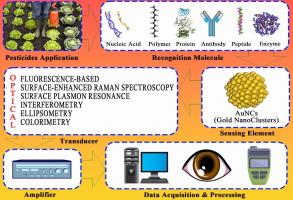Surface functionalized gold nanoclusters based on optical biosensors for detecting pesticide residues in agricultural foods: A critical review
IF 4.9
2区 化学
Q1 CHEMISTRY, ANALYTICAL
引用次数: 0
Abstract
Pesticides play a crucial role in modern agriculture for managing pests; however, their indiscriminate application raises concerns regarding food safety. It is, therefore, necessary to advance effective and rapid techniques for detecting pesticide residues in food products and water. Gold nanoclusters (AuNCs) are considered a versatile group due to their diverse functionality and attractive optoelectronic and photoluminescence characteristics, indicating significant promise in food safety. Specifically, AuNCs optical biosensors have been featured as universal and versatile tools for manufacturing new-generation recognizing approaches with enhanced sensitivity, stability, and specificity. In this review, we explore the latest tests and tools that utilize optical sensors with AuNCs for detecting pesticides. The review explores the evolution of these sensors and their innovative strategies for attaching recognition elements to AuNCs, both chemically and physically. Additionally, the article explores the synthesis principle, sensing mechanism, and recent advancements in using AuNCs as optical biosensors to detect pesticides. Furthermore, it explores the utilization of optical AuNC probes in ensuring food safety and the obstacles that may arise during their incorporation, drawing from the latest developments in this area.

基于光学生物传感器的表面功能化金纳米团簇用于检测农业食品中的农药残留:重要综述
农药在现代农业管理害虫方面发挥着至关重要的作用;然而,农药的滥用引发了人们对食品安全的担忧。因此,有必要推进有效而快速的技术,以检测食品和水中的农药残留。金纳米团簇(AuNCs)具有多种功能和诱人的光电和光致发光特性,因此被认为是一种用途广泛的材料,在食品安全方面大有可为。具体来说,AuNCs 光学生物传感器是制造新一代识别方法的通用工具,具有更高的灵敏度、稳定性和特异性。在本综述中,我们将探讨利用 AuNCs 光学传感器检测农药的最新测试和工具。该综述探讨了这些传感器的演变过程,以及通过化学和物理方法将识别元件附着到 AuNCs 上的创新策略。此外,文章还探讨了将 AuNCs 用作光学生物传感器检测农药的合成原理、传感机制和最新进展。此外,文章还借鉴该领域的最新进展,探讨了如何利用 AuNC 光学探针确保食品安全,以及在使用过程中可能遇到的障碍。
本文章由计算机程序翻译,如有差异,请以英文原文为准。
求助全文
约1分钟内获得全文
求助全文
来源期刊

Microchemical Journal
化学-分析化学
CiteScore
8.70
自引率
8.30%
发文量
1131
审稿时长
1.9 months
期刊介绍:
The Microchemical Journal is a peer reviewed journal devoted to all aspects and phases of analytical chemistry and chemical analysis. The Microchemical Journal publishes articles which are at the forefront of modern analytical chemistry and cover innovations in the techniques to the finest possible limits. This includes fundamental aspects, instrumentation, new developments, innovative and novel methods and applications including environmental and clinical field.
Traditional classical analytical methods such as spectrophotometry and titrimetry as well as established instrumentation methods such as flame and graphite furnace atomic absorption spectrometry, gas chromatography, and modified glassy or carbon electrode electrochemical methods will be considered, provided they show significant improvements and novelty compared to the established methods.
 求助内容:
求助内容: 应助结果提醒方式:
应助结果提醒方式:


